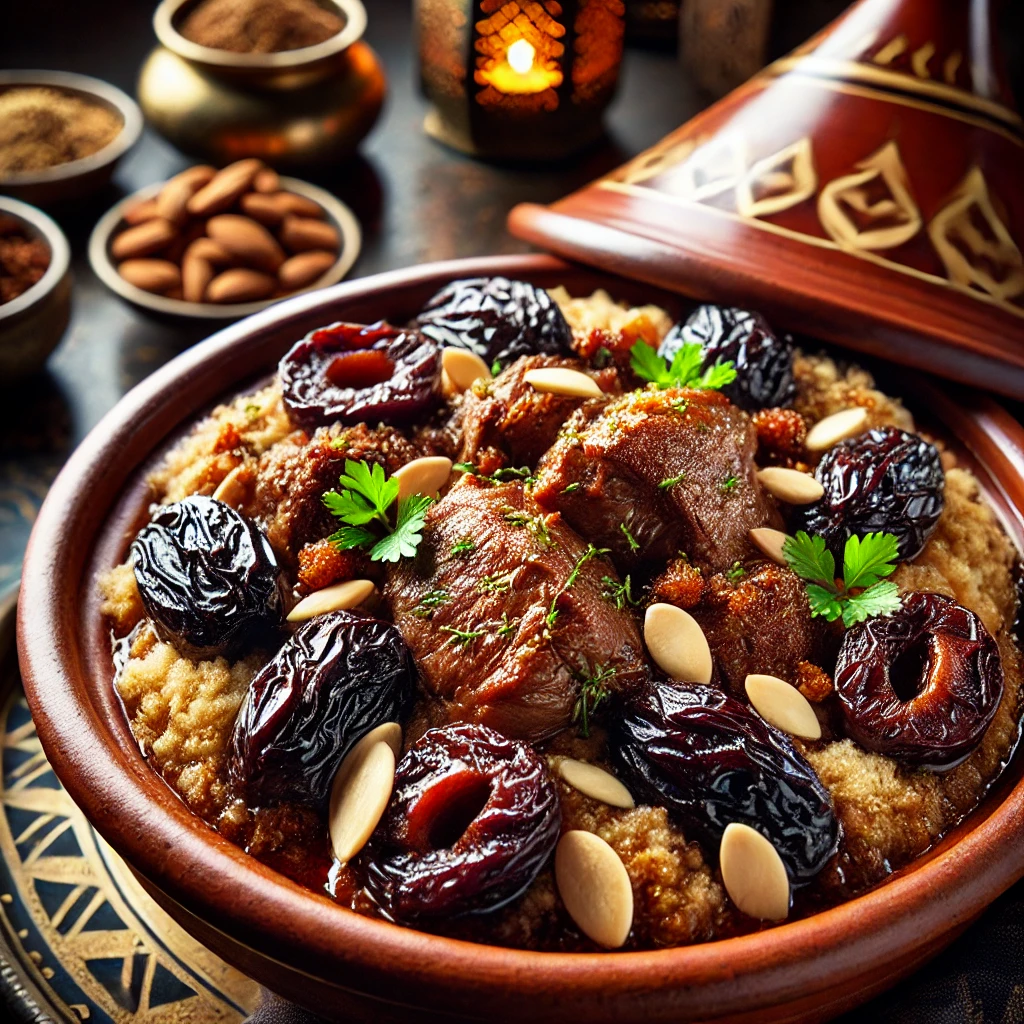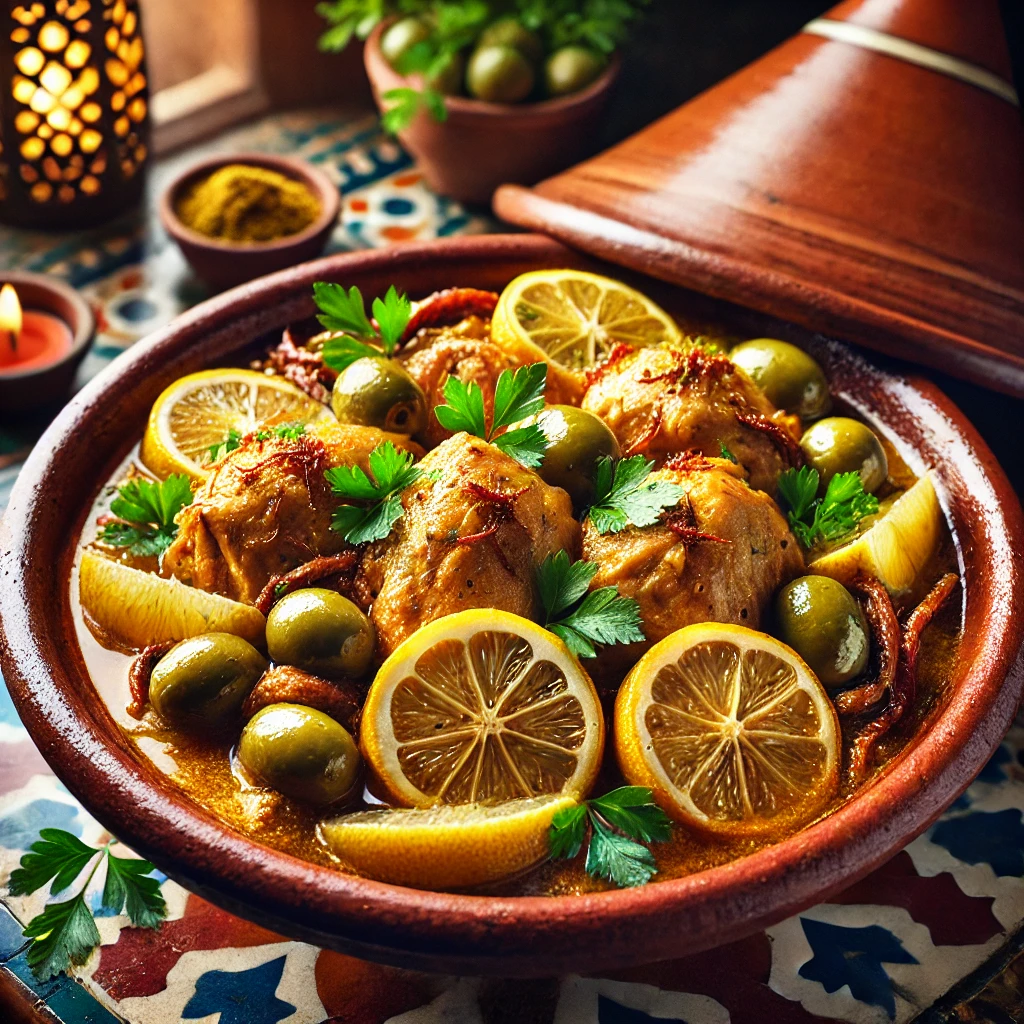Introduction
Moroccan cuisine is a rich tapestry of flavors, aromas, and traditions, with its dishes reflecting the country’s diverse cultural influences. At the heart of this culinary landscape is the iconic Moroccan Tajine, a dish as much about its method of cooking as it is about the ingredients it brings together. Named after the distinctive earthenware pot in which it is cooked, Tajine is a slow-cooked stew, typically involving a variety of meats, vegetables, and aromatic spices, simmered to perfection. This dish is more than just a meal; it’s an experience, a connection to centuries of tradition, and a symbol of Moroccan hospitality.
The Origins of Tajine
The origins of Tajine are deeply rooted in the history of Morocco, a country that has been a crossroads of cultures for centuries. The word “tajine” itself comes from the Berber language, a reflection of the dish’s indigenous roots. Berbers, who are among the earliest inhabitants of North Africa, developed the tajine as a practical solution to cooking in the harsh desert environment. The conical shape of the tajine pot allowed them to create flavorful meals using minimal water, a precious resource in the arid landscape.
As traders and travelers passed through Morocco, they brought with them spices, ingredients, and cooking techniques from the Mediterranean, Middle East, and Sub-Saharan Africa. These influences were absorbed into Moroccan cuisine, enriching the flavors of the Tajine. Over time, Tajine became a staple in Moroccan homes, its recipes passed down through generations, each family adding its own unique twist to the dish.
The Art of Cooking Tajine
Cooking Tajine is as much an art as it is a science. The dish is traditionally prepared in a clay pot, which consists of two parts: a wide, shallow base where the ingredients are placed, and a conical lid that helps circulate the steam, ensuring the food is cooked evenly while retaining moisture and flavor. The pot is designed to be used over low, steady heat, often over an open flame or in a traditional Moroccan brazier known as a “kanoun.”
One of the key aspects of cooking a Tajine is the layering of ingredients. Typically, vegetables such as onions, carrots, and potatoes form the base, creating a cushion for the meat, which is often lamb, chicken, or beef. The choice of meat can vary, with lamb being particularly prized for its tenderness and rich flavor. The vegetables and meat are then seasoned with a blend of spices—cumin, coriander, ginger, saffron, and cinnamon, to name a few—creating a complex and aromatic flavor profile.
Once the ingredients are layered, the Tajine is left to cook slowly, allowing the flavors to meld together. This slow-cooking process is crucial, as it ensures that the meat becomes tender and the spices have time to infuse every layer of the dish. The result is a meal that is both comforting and deeply flavorful, with each bite offering a taste of Morocco’s rich culinary heritage.
Popular Varieties of Tajine
While the basic concept of Tajine remains the same, there are countless variations of the dish, each reflecting the ingredients and tastes of different regions in Morocco. Here are some of the most popular types of Tajine:
- Lamb Tajine with Prunes and Almonds: This is one of the most iconic Moroccan Tajines, where tender lamb is slow-cooked with sweet prunes, honey, and a mix of spices, then garnished with toasted almonds. The combination of savory and sweet flavors, along with the crunchy texture of the almonds, makes this dish a favorite at Moroccan celebrations.
- Chicken Tajine with Preserved Lemons and Olives: A classic and widely loved version of Tajine, this dish features chicken pieces simmered with preserved lemons, green olives, and a mixture of spices including saffron and turmeric. The preserved lemons add a tangy, slightly salty flavor that contrasts beautifully with the richness of the chicken.
- Kefta Tajine with Eggs: Kefta (spiced ground meat, usually beef or lamb) is shaped into small meatballs and cooked in a tomato-based sauce, spiced with cumin and paprika. Near the end of cooking, eggs are cracked into the sauce and poached, creating a hearty and satisfying meal.
- Vegetable Tajine: For a vegetarian option, the vegetable Tajine is a celebration of seasonal produce. It typically includes a mix of root vegetables, zucchini, bell peppers, and tomatoes, all simmered with spices and sometimes dried fruits like apricots or raisins. The result is a dish that is both wholesome and bursting with flavor.
- Fish Tajine: Popular in coastal regions, this version of Tajine features fish (such as sardines or sea bream) marinated in a chermoula (a mix of herbs, garlic, lemon, and spices) and then cooked with vegetables like potatoes, tomatoes, and bell peppers. The fish remains tender and absorbs the tangy, spicy flavors of the marinade.
The Cultural Significance of Tajine
Tajine is more than just a meal in Morocco; it is a symbol of community and tradition. The preparation and sharing of a Tajine is a social activity, often bringing together family and friends. In Moroccan culture, meals are meant to be shared, and the Tajine, with its communal serving style, embodies this ethos perfectly. The dish is typically served with Moroccan bread, known as “khobz,” which is used to scoop up the flavorful stew directly from the pot.
In addition to being a staple of everyday life, Tajine plays a central role in Moroccan celebrations and special occasions. Whether it’s a wedding, a religious holiday, or a simple family gathering, Tajine is often at the heart of the feast, showcasing the richness of Moroccan hospitality.
Tajine Beyond Morocco
In recent years, the allure of Moroccan Tajine has spread beyond the borders of Morocco, captivating food lovers around the world. Its unique cooking method and the rich, aromatic flavors have made it a favorite in global kitchens. Many chefs and home cooks have embraced the Tajine pot, experimenting with both traditional recipes and new, innovative variations.
The availability of Tajine pots and Moroccan spices in international markets has made it easier than ever for people to recreate this dish at home. However, while the ingredients and the pot are important, it’s the slow, deliberate cooking process and the care that goes into each step that truly makes a Tajine special.
Conclusion
Moroccan Tajine is more than just a dish; it’s a journey into the heart of Morocco’s culinary traditions. With its rich history, diverse variations, and the communal spirit it embodies, Tajine represents the essence of Moroccan culture. Whether enjoyed in a bustling Marrakech souk or in the comfort of your home, each bite of Tajine offers a taste of Morocco’s rich, flavorful heritage. As more people around the world discover and appreciate this iconic dish, the legacy of the Tajine continues to grow, connecting cultures and bringing people together through the universal language of food.







